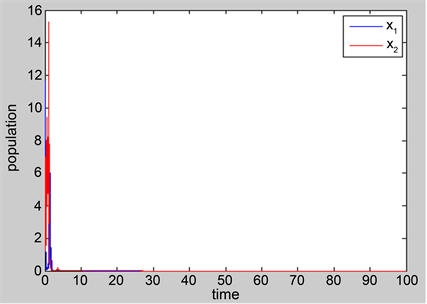Pure Mathematics
Vol.
10
No.
06
(
2020
), Article ID:
36274
,
17
pages
10.12677/PM.2020.106074
Asymptotic Behavior of a Stochastic Hybrid Mutualism System with Lévy Jumps
Dandan Liu, Xiaoquan Ding*
School of Mathematics and Statistics, Henan University of Science and Technology, Luoyang Henan

Received: May 30th, 2020; accepted: Jun. 21st, 2020; published: Jun. 28th, 2020

ABSTRACT
This paper is concerned with the asymptotic behavior of a stochastic mutualism system driven by Lévy jumps under Markovian switching. By using Lyapunov functions and some techniques in stochastic calculus, the sufficient conditions for stochastic permanence, extinction, and persistence in mean are established respectively. Finally, some numerical simulations are given to illustrate our theoretical results.
Keywords:Mutualism System, Markovian Switching, Lévy Jump, Stochastic Permanence, Extinction

一类带Lévy跳的随机混杂互惠系统的渐近性态
刘丹丹,丁孝全*
河南科技大学数学与统计学院,河南 洛阳

收稿日期:2020年5月30日;录用日期:2020年6月21日;发布日期:2020年6月28日

摘 要
本文讨论一类带Lévy跳和Markov切换的随机互惠系统的渐近性态。利用Lyapunov函数和随机分析工具,建立了系统的随机持久性、灭绝性和平均意义下的持续性。数值模拟验证了理论结果的合理性。
关键词 :互惠系统,Markov切换,Lévy跳,随机持久,灭绝

Copyright © 2020 by author(s) and Hans Publishers Inc.
This work is licensed under the Creative Commons Attribution International License (CC BY 4.0).
http://creativecommons.org/licenses/by/4.0/


1. 引言
近年来,带有高斯白噪声扰动的种群模型受到广泛关注,并取得了丰富的研究成果 [1] - [6]。而现实世界中,还存在着其它噪声,其中一些可能使种群系统存在状态随机切换,还有一些可能使种群数量在短时间内发生巨大变化,更合理的种群模型还应包括这些随机因素 [7] - [15]。特别地,在自然界中,种群之间的互惠关系是非常普遍的,许多学者对各种互惠种群模型进行了深入研究 [16] - [29]。
为探讨各种噪声对互惠种群模型的动力学行为的综合影响,受文献 [14] [15] [29] 的启发,本文考虑下列带Lévy跳的随机混杂互惠系统:
(1.1)
其中 表示第l个种群在时刻t的密度, 表示 的左极限; 是定义在带流概率空间 上的二维标准Brown运动,r是状态空间为S的连续时间Markov链;N是特征测度 在 的可测子集Y上满足 的Poisson计数测度, 是其补偿测度。对任意 ,, 为高斯白噪声的强度;函数 有界可测且 ; 为正常数,相应的生物意义参见文献 [18]。
我们指出,与系统(1.1)对应的确定性自治模型最早由Graves等人 [18] 提出并研究,向等人 [19] 则考虑了相应的确定性非自治模型;仅包含高斯白噪声的情形首先由吕 [20] 研究,郭和丁 [21] 则讨论了其相应的非自治形式。据我们所知,关于系统(1.1)的研究还未见相关报道。本文旨在利用随机微分方程理论 [30] [31] [32],探讨系统(1.1)的正解的全局存在唯一性、随机持久性、灭绝性和平均意义下的持续性。
本文后续内容安排如下:第2节,给出一些准备工作;第3节,证明正解的全局存在唯一性;第4节,建立系统的随机持久性;第5节,讨论灭绝性和平均意义下的持续性;最后,数值模拟验证理论结果的合理性。
2. 准备工作
本节介绍一些定义、引理、假设和记号。
为方便讨论,给出以下记号:
1) ;
2) ,, ;
3) ,,。
设 是带流完备概率空间,其中流 满足通常条件。Markov链 的状态空间 ,其生成元 由
给出。其中, , 是从i到j的转移速率,并且 。本文假定随机过程r,N和 是相互独立的,并且对任意的 ,有 。因此,Q不可约,r是遍历的Markov链,Q存在唯一的不变分布 满足 及 ,,。
考虑线性方程
(2.1)
其中 为列向量。
引理2.1. ( [30], p. 363) 下列断言成立:
1) 方程(2.1)有解的充要条件是 。
2) 若 和 是(2.1)的两个解,则存在 使得 ,其中 为m个元素全为1的列向量。
3) 方程(2.1)的任意解可以表示成 ,其中 是任意常数, 是方程(2.1)满足 的唯一解。
再考虑带有Lévy跳和Markov切换的随机微分方程:
(2.2)
其中
若对任意 ,函数 关于t连续可微,关于x二次连续可微,则由Itô公式可知
其中
下面给出随机最终有界、随机持久、灭绝以及平均意义下持续的定义。
定义2.1. 若对任意 ,存在正常数 ,使得对初值 ,系统(1.1)的解 满足
则称系统(1.1)的解是随机最终有上界的。
定义2.2. 若对任意的 ,存在正常数 ,使得对初值 ,系统(1.1)的解 满足
则称系统(1.1)的解是随机最终有下界的。
定义2.3. 如果系统(1.1)的解既随机最终有上界又随机最终有下界,则称系统(1.1)是随机持久的。
定义 2.4. 设 是系统(1.1)的正解, 。
1) 若 a.s.,则称种群 是灭绝的;
2) 若 a.s.,则称种群 在平均意义下是非持续的;
3) 若 a.s.,则称种群 在平均意义下是强持续的。
下面是带有Lévy跳的指数鞅不等式。
引理 2.2. ( [31], p. 291) 设 为 -适应可料过程,若对任意 满足
则对任意 ,有
3. 正解的全局存在性与唯一性
本节建立系统(1.1)的全局正解的存在唯一性,这是本文后续工作的基础。
定理3.1. 对任意初值 ,系统(1.1)存在唯一的全局解 ,并且该解以概率1停留在 中。
证明:易知系统(1.1)的系数满足局部Lipschitz条件,由随机微分方程解的存在唯一性定理可知,系统(1.1)在区间 上存在唯一的局部解 ,其中 是爆破时刻。下面证明 是全局
的,即证明 几乎必然成立。取充分大的正整数 ,使 和 。对任意
正整数 ,定义停时:
对于空集 ,规定 。易知 是一个单调递增序列。令 ,则 。若证明 ,则 。
下面用反证法证明 几乎必然成立。若该结论不成立,则存在常数 和 ,使得
从而存在正整数 ,对任意正整数 ,有
(3.1)
定义Lyapunov函数:
显然,对任意 ,。由Itô公式可得
(3.2)
其中
(3.3)
记
则M为正常数。对(3.2)两边从0到 积分,然后取数学期望,再结合(3.3)可得
(3.4)
对 ,记 。由 的定义可知,对每个 , 和 中至少有一个等于k或1/k。由(3.1)和(3.4)可知
其中 是 的示性函数。令 ,可得
矛盾。所以 几乎必然成立。证毕。
4. 随机持久性
本节利用系统(1.1)的解的矩估计,证明其解的随机最终有界性,并进而得到系统的随机持久性。
引理4.1. 对任意 ,存在正常数 ,使得对任意初值 ,系统(1.1)的解 满足
(4.1)
证明:由定理3.1知,对于任意初值 ,系统(1.1)存在全局唯一解 ,且以概率1停留在 中。定义Lyapunov函数
由Itô公式可得
(4.2)
其中
(4.3)
记
由Bernoulli不等式可知
从而
(4.4)
易知, 是与p有关的正常数。对(4.4)两边从0到t积分,然后取数学期望,再利用(4.2)和(4.3)可得
从而
令 可得
对 的情况,同理可证。证毕。
定理4.1. 系统(1.1)的解是随机最终有上界的。
证明:记 ,对任意 ,令 ,由Chebyshev不等式可得
结合引理4.1中的(4.1)可得
从而
证毕。
下面证明系统(1.1)的解是随机最终有下界的。为此,令
(4.5)
由Itô公式可得
(4.6)
引理4.2. 若 ,则对任意充分小的 ,存在正常数L,使得对任意初值 ,,系统(1.1)的解 满足
(4.7)
证明:由(4.5),只需证明
注意到
由引理2.1可知方程
有解 。因此
取 ,使得对每一 ,有
定义Lyapunov函数
由(4.6)可得
(4.8)
根据生成元Q的性质可知
(4.9)
由Bernoulli不等式可知
 (4.10)
(4.10)
将(4.9)和(4.10)代入(4.8)可得

 (4.11)
(4.11)
取常数 ,使得对任意的
,使得对任意的 ,有
,有

再取充分小常数 ,使得
,使得
 (4.12)
(4.12)
记
 (4.13)
(4.13)
由(4.12)易知,H是与 有关的正常数。由(4.11)和(4.13)可得
有关的正常数。由(4.11)和(4.13)可得
 (4.14)
(4.14)
由Itô公式,并结合(4.14)可知

从而

其中

因此

令 可得
可得

证毕。
定理4.2. 若 ,则系统(1.1)的解是随机最终有下界的。
,则系统(1.1)的解是随机最终有下界的。
证明:对任意 ,令
,令 ,由Chebyshev不等式可得
,由Chebyshev不等式可得

结合引理4.2中的(4.7)可得

从而

证毕。
联合定理4.1与定理4.2即得
定理4.3. 若 ,则系统(1.1)是随机持久的。
,则系统(1.1)是随机持久的。
5. 灭绝性与平均意义下的持续性
本节讨论系统(1.1)的灭绝性和平均意义下的持续性。为此,先利用引理2.2建立如下引理。
引理 5.1. 对任意初值 ,系统(1.1)的解
,系统(1.1)的解 满足
满足

证明:对任意 ,由Itô公式可知
,由Itô公式可知
 (5.1)
(5.1)
注意到对任意 和
和 ,有
,有

由(5.1)可知
 (5.2)
(5.2)
根据引理2.2,对任意 ,有
,有

取 ,其中
,其中 。因为
。因为 ,根据Borel-Cantelli
,根据Borel-Cantelli
引理,存在 满足
满足 ,使得对任意
,使得对任意 ,存在正整数
,存在正整数 ,当
,当 时,成立
时,成立
 (5.3)
(5.3)
由Bernoulli不等式可知
 (5.4)
(5.4)
(5.2)式两边同除 ,再利用(5.3)和(5.4)可知,对任意
,再利用(5.3)和(5.4)可知,对任意 ,当
,当 ,
, 时,有
时,有

令 可得
可得

再令 ,可得
,可得

从而

对 的情况,同理可证。证毕。
的情况,同理可证。证毕。
下面依次给出灭绝性、平均意义下的非持续性和强持续性。
定理5.1. 对任意初值 ,系统(1.1)的解
,系统(1.1)的解 满足
满足
 (5.5)
(5.5)
特别的,如果 ,则种群
,则种群 趋于灭绝。
趋于灭绝。
证明:记
 。
。
由定理3.1知,对于任意初值 ,系统(1.1)存在全局唯一解
,系统(1.1)存在全局唯一解 ,且以概率1停留在
,且以概率1停留在 中。由Itô公式可得
中。由Itô公式可得
 (5.6)
(5.6)
其中
 和
和
是局部平方可积鞅,并且

根据局部鞅的大数定律 [32] 可知
 (5.7)
(5.7)
(5.6)式两边同除t,然后取上极限,再利用(5.7)和Markov链 的遍历性可得
的遍历性可得

同理可知

特别的,若 ,则有
,则有

从而

即种群 趋于灭绝。证毕
趋于灭绝。证毕
定理5.2. 若 ,则种群
,则种群 在平均意义下非持续。
在平均意义下非持续。
证明:若 ,由Markov链
,由Markov链 的遍历性可知
的遍历性可知
 (5.8)
(5.8)
任给 ,由(5.7)和(5.8)可知,存在正数T,对任意
,由(5.7)和(5.8)可知,存在正数T,对任意 ,有
,有

代入(5.6)可知,对任意 ,有
,有

设 ,则对任意
,则对任意 ,有
,有

或者

两边从T到t积分可得

从而

两边同除t,再取上极限可得

由 的任意性,可知
的任意性,可知

从而

同理可证,若 ,则
,则

证毕。
定理5.3. 若 ,则种群
,则种群 在平均意义下强持续。
在平均意义下强持续。
证明:由Itô公式可知
 (5.9)
(5.9)
两边同除t,并移项可得

两边取下极限,并利用引理5.1和(5.7)式可得

若 ,则
,则

对 的情况,同理可证。证毕。
的情况,同理可证。证毕。
6. 数值模拟
为验证理论分析结果,本节采用Milstein方法 [33] 对系统(1.1)进行数值模拟。
例6.1 在系统(1.1)中,设Markov链 的状态空间
的状态空间 ,生成元
,生成元

易知Q存在唯一不变分布

给定初值 ,且
,且 ,其它系数取值如下:
,其它系数取值如下:

经简单计算可知


满足定理4.3的条件。从图1可知系统(1.1)是随机持久的。
例6.2 在系统(1.1)中,设Markov链 的状态空间
的状态空间 ,生成元
,生成元

易知Q存在唯一不变分布


Figure 1. A solution of system (1.1) with 
图1. 当 时系统(1.1)的解
时系统(1.1)的解

Figure 2. A solution of system (1.1) with 
图2. 当 时系统(1.1)的解
时系统(1.1)的解
给定初值 ,且
,且 ,其它系数取值如下:
,其它系数取值如下:

经简单计算可知


满足定理5.1的条件。从图2可知系统(1.1)是灭绝的。
基金项目
本文得到国家自然科学基金项目(11271110)和河南省教育厅科技攻关项目(15A120009)的支持。
文章引用
刘丹丹,丁孝全. 一类带Lévy跳的随机混杂互惠系统的渐近性态
Asymptotic Behavior of a Stochastic Hybrid Mutualism System with Lévy Jumps[J]. 理论数学, 2020, 10(06): 605-621. https://doi.org/10.12677/PM.2020.106074
参考文献
- 1. Gard, T.C. (1986) Stability for Multispecies Population Models in Random Environments. Nonlinear Analysis, 10, 1411-1419. https://doi.org/10.1016/0362-546X(86)90111-2
- 2. Mao, X., Renshaw, E., and Marion, G. (2002) Environmental Brownian Noise Suppresses Explosions in Population Dynamics. Stochastic Processes and Their Ap-plications, 97, 95-110. https://doi.org/10.1016/S0304-4149(01)00126-0
- 3. Rudnicki, R. and Pichór, K. (2007) Influence of Stochastic Perturbation on Prey-Predator Systems. Mathematical Biosciences, 206, 108-119. https://doi.org/10.1016/j.mbs.2006.03.006
- 4. Ji, C., Jiang, D. and Shi, N. (2009) Analysis of a Predator-Prey Model with Modified Leslie-Gower and Holling-Type II Schemes with Stochastic Perturbation. Journal of Mathematical Analysis and Applications, 359, 482-498. https://doi.org/10.1016/j.jmaa.2009.05.039
- 5. Mandal, P.S. and Banerjee, M. (2012) Stochastic Persistence and Stationary Distribution in a Holling-Tanner Type Prey-Predator Model. Physica A, 391, 1216-1233. https://doi.org/10.1016/j.physa.2011.10.019
- 6. 王克. 随机生物数学模型[M]. 北京: 科学出版社, 2010.
- 7. Li, X., Gray, A., Jiang, D. and Mao, X. (2011) Sufficient and Necessary Conditions of Stochastic Perma-nence and Extinction for Stochastic Logistic Populations under Regime Switching. Journal of Mathematical Analysis and Applications, 376, 11-28. https://doi.org/10.1016/j.jmaa.2010.10.053
- 8. Settati, A. and Lahrouz, A. (2015) On Stochastic Gilpin-Ayala Population Model with Markovian Switching. Biosystems, 130, 17-27. https://doi.org/10.1016/j.biosystems.2015.01.004
- 9. Yang, H., Li, X. and Yin, G. (2016) Permanence and Ergodicity of Stochastic Gilpin-Ayala Population Model with Regime Switching. Discrete and Continuous Dynamical Systems, 21, 3743-3766. https://doi.org/10.3934/dcdsb.2016119
- 10. Bao, J., Mao, X., Yin, G., and Yuan, C. (2011) Competitive Lotka-Volterra Population Dynamics with Jumps. Nonlinear Analysis, 74, 6601-6616. https://doi.org/10.1016/j.na.2011.06.043
- 11. Bao, J. and Yuan, C. (2012) Stochastic Population Dynamics Driven by Lévy Noise. Journal of Mathematical Analysis and Applications, 391, 363-375. https://doi.org/10.1016/j.jmaa.2012.02.043
- 12. Liu, Q. and Liang, Y. (2014) Persistence and Extinction of a Stochastic Non-Autonomous Gilpin-Ayala System Driven by Lévy Noise. Communications in Nonlinear Science and Numerical Simulation, 19, 3745-3752. https://doi.org/10.1016/j.cnsns.2014.02.027
- 13. Lu, C. and Ding, X. (2015) Persistence and Extinction of a Sto-chastic Gilpin-Ayala Model with Jumps. Mathematical Methods in the Applied Sciences, 38, 1200-1211. https://doi.org/10.1002/mma.3143
- 14. Wu, R., Zou, X., Wang, K., and Liu, M. (2014) Stochastic Lotka-Volterra Systems under Regime Switching with Jumps. Filomat, 9, 1907-1928. https://doi.org/10.2298/FIL1409907W
- 15. Zhao, Y. and Yuan, S. (2016) Stability in Distribution of a Stochastic Hybrid Competitive Lotka-Volterra Model with Lévy Jumps. Chaos, Solitons and Fractals, 85, 98-109. https://doi.org/10.1016/j.chaos.2016.01.015
- 16. Boucher, D.H. (1985) The Biology of Mutualism: Ecology and Evolution. Oxford University Press, New York.
- 17. 陈凤德, 谢向东. 合作种群模型动力学研究[M]. 北京: 科学出版社, 2014.
- 18. Graves, W.G., Peckham, B. and Pastor, J. (2006) A Bifurcation Analysis of a Differential Equa-tions Model for Mutualism. Bulletin of Mathematical Biology, 68, 1851-1872. https://doi.org/10.1007/s11538-006-9070-3
- 19. 向红, 张小兵, 孟新友. 一类互惠模型的持续生存与周期解[J]. 兰州交通大学学报, 2009, 28(4): 156-158.
- 20. 吕敬亮. 几类随机生物种群模型性质的研究[D]: [博士学位论文]. 哈尔滨: 哈尔滨工业大学, 2011.
- 21. 郭奥, 丁孝全. 一类非自治随机互惠系统的渐近性态[J]. 理论数学, 2019, 9(4): 514-526.
- 22. Ji, C. and Jing, D. (2012) Persistence and Non-Persistence of a Mutualism System with Stochastic Perturbation. Discrete and Continuous Dynamical Systems, 32, 867-889. https://doi.org/10.3934/dcds.2012.32.867
- 23. Li, M., Gao, H., Sun, C. and Gong, Y. (2015) Analysis of a Mutu-alism Model with Stochastic Perturbations. International Journal of Biomathematics, 8, Article ID: 1550072. https://doi.org/10.1142/S1793524515500722
- 24. Liu, M. and Wang, K. (2013) Analysis of a Stochastic Auton-omous Mutualism Model. Journal of Mathematical Analysis and Applications, 402, 392-403. https://doi.org/10.1016/j.jmaa.2012.11.043
- 25. Guo, S. and Hu, Y. (2017) Asymptotic Behavior and Numerical Simulations of a Lotka-Volterra Mutualism System with White Noises. Advances in Difference Equations, 2017, Article No. 125. https://doi.org/10.1186/s13662-017-1171-9
- 26. Han, Q. and Jiang, D. (2015) Periodic Solution for Stochastic Non-Autonomous Multispecies Lotka-Volterra Mutualism Type Ecosystem. Applied Mathematics and Computation, 262, 204-217. https://doi.org/10.1016/j.amc.2015.04.042
- 27. Zhang, X., Jiang, D., Alsaedi, A. and Hayat, T. (2016) Periodic Solutions and Stationary Distribution of Mutualism Models in Random Environments. Physica A, 460, 270-282. https://doi.org/10.1016/j.physa.2016.05.015
- 28. Wang, B., Gao, H. and Li, M. (2017) Analysis of a Non-Autonomous Mutualism Model Driven by Lévy Jumps. Discrete and Continuous Dynamical Systems—Series B, 21, 1189-1202. https://doi.org/10.3934/dcdsb.2016.21.1189
- 29. Gao, H. and Wang, Y. (2019) Stochastic Mutu-alism Model under Regime Switching with Lévy Jumps. Physica A, 515, 355-375. https://doi.org/10.1016/j.physa.2018.09.189
- 30. Yin, G. and Zhu, C. (2010) Hybrid Switching Diffusions. Springer-Verlag, New York. https://doi.org/10.1007/978-1-4419-1105-6
- 31. Applebaum, D. (2009) Lévy Processes and Stochastics Calculus. 2nd Edition, Cambridge University Press, New York. https://doi.org/10.1017/CBO9780511809781
- 32. Mao, X. and Yuan, C. (2006) Stochastic Differential Equations with Markovian Switching. Imperial College Press, London. https://doi.org/10.1142/p473
- 33. Higham, D.J. (2001) An Algorithmic Introduction to Numerical Simulation of Stochastic Differential Equations. SIAM Review, 43, 525-546. https://doi.org/10.1137/S0036144500378302
NOTES
*通讯作者。